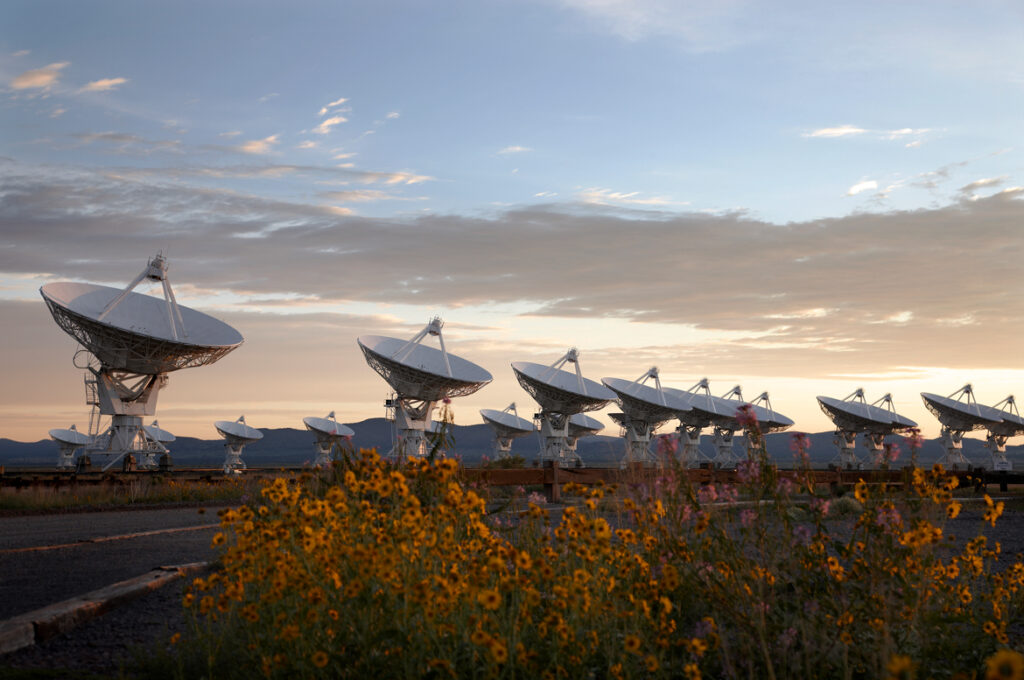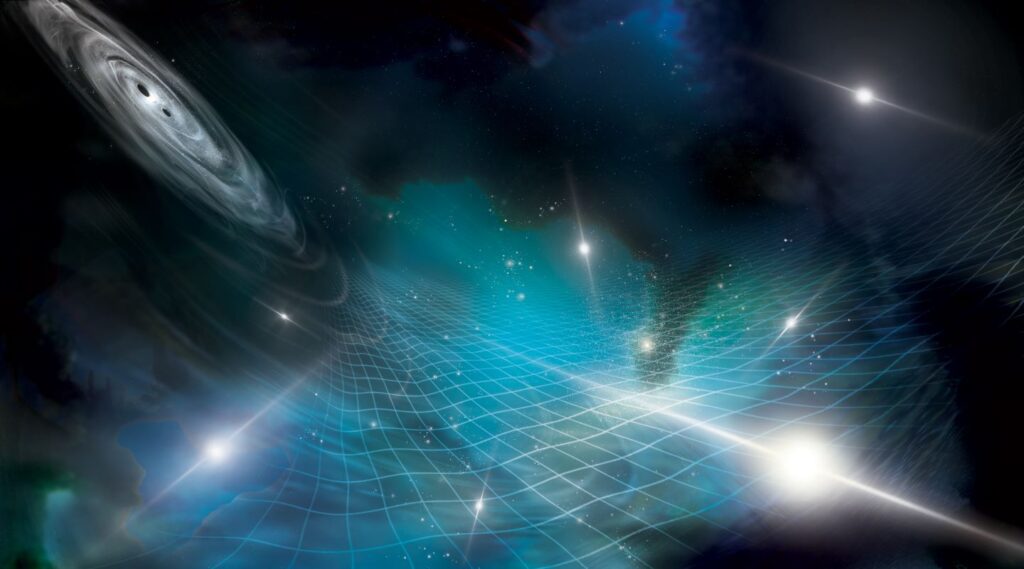Scientists use exotic stars to tune into hum from cosmic symphony
Astrophysicists using large radio telescopes to observe a collection of cosmic clocks in our galaxy have found evidence for gravitational waves that oscillate with periods of years to decades, according to a set of papers published June 28 in The Astrophysical Journal Letters.
The gravitational-wave signal was observed in 15 years of data acquired by the North American Nanohertz Observatory for Gravitational Waves (NANOGrav) Physics Frontiers Centers (PFC), a collaboration of more than 190 scientists from the U.S. and Canada who use pulsars to search for gravitational waves.
One of those scientists, David Nice, professor and head of physics at Lafayette College and a founding member of NANOGrav, says the new measurements of gravitational waves, likely emitted by the motion of distant black holes, marks a major milestone that further confirms Einstein’s theory of relativity.
“About 15 years ago, we began a program to make systematic and extremely precise measurements of pulsars, rapidly rotating remnants of what were once massive stars. We started by observing 17 pulsars once a month. These pulsars are distributed throughout our local region of the Milky Way galaxy,” Nice says. “Each one is thousands of light years away from the Earth. We call this a pulsar timing array. We slowly built up the array over the years, and we now make monthly measurements of more than 80 pulsars.”
Einstein’s theory of relativity predicts that the signals we measure will be perturbed by passing gravitational waves, oscillate in the fabric of space and time that persist over periods of many years, he says.
“Our goal has been to detect these perturbations and hence to make measurements of these gravitational waves,” Nice says. “After 15 years, we now have strong evidence that these gravitational waves actually exist.”
Over the years, the NANOGrav project has provided tremendous opportunities for Nice and his students to experience cutting-edge research and to develop and hone their data analysis skills. They gathered data using the massive Arecibo Observatory in Puerto Rico and the Green Bank Telescope in West Virginia, some of which was collected while the telescopes were controlled remotely using computers at Lafayette. They modeled when the pulses should arrive at the telescope in the absence of gravitational waves and compare that to the actual arrival times.
“Pulsar signals are really remarkable,” Nice says. “They consist of pulses of radio waves. It takes pulses thousands of years to travel from a pulsar to the Earth, yet we can predict when these pulses will arrive at our telescopes with precision of a millionth of a second. If the pulses are just a little bit off—for example, if their travel through space was affected by gravitational waves—this is something we can measure.”
“This discovery allows us to start to get a handle on the population of supermassive black holes that are creating these gravitational waves,” Nice says. “Beyond the significance of this discovery, another important aspect of this work is the involvement of students. They learn about electronics, telescopes, and signal processing. They learn about computational data processing, coding, how to think about data analysis, how to deal with the fact that real world data is really messy,” he adds. “Working on this real-world research project exposes them to areas that they just won’t see in the classroom and won’t see otherwise.”
“This is the first evidence for gravitational waves at very low frequencies,” says Vanderbilt University’s Dr. Stephen Taylor, who co-led the search and is the current chair of the collaboration. “After years of work, NANOGrav is opening an entirely new window on the gravitational-wave universe.”
Unlike the fleeting high-frequency gravitational waves seen by ground-based instruments like LIGO (the Laser Interferometer Gravitational-wave Observatory), this continuous low-frequency signal could be perceived only with a detector much larger than Earth. To meet this need, astronomers began the program of observing pulsars thousands of light years from Earth.
A pulsar is the ultra-dense remnant of a massive star’s core following its demise in a supernova explosion. Pulsars spin rapidly, sweeping beams of radio waves through space so that they appear to “pulse” when seen from Earth. The fastest of these objects, called millisecond pulsars, spin hundreds of times each second. Their pulses are very stable, making them useful as precise cosmic timepieces.
Over 15 years of observations with the Arecibo Observatory in Puerto Rico, the Green Bank Telescope in West Virginia, and the Very Large Array in New Mexico, NANOGrav has gradually expanded the number of pulsars they observe. “Pulsars are actually very faint radio sources, so we require thousands of hours a year on the world’s largest telescopes to carry out this experiment,” explains Dr. Maura McLaughlin of West Virginia University and co-director of the NANOGrav PFC. “These results are made possible through the National Science Foundation’s continued commitment to these exceptionally sensitive radio observatories.”

The National Science Foundation funds the iconic Y-shaped array of 27 25-meter diameter dishes in New Mexico. The array can see far into the Southern sky, making it a key instrument for NANOGrav’s pulsar timing. Photo credit: NRAO/AUI/NSF
Einstein’s theory of general relativity predicts precisely how gravitational waves should affect pulsar signals. By stretching and squeezing the fabric of space, gravitational waves affect the timing of each pulse in a small but predictable way, delaying some while advancing others. These shifts are correlated for all pairs of pulsars in a way that depends on how far apart the two stars appear in the sky.
“The large number of pulsars used in the NANOGrav analysis has enabled us to see what we think are the first signs of the correlation pattern predicted by general relativity,” says Oregon State University’s Dr. Xavier Siemens, co-director of the NANOGrav PFC.
NANOGrav’s most recent dataset shows growing evidence for gravitational waves with periods of years to decades. These waves could arise from orbiting pairs of the most massive black holes in the entire universe—billions of times more massive than the sun, with sizes larger than the distance between Earth and the sun. Future studies of this signal will open a new window on the gravitational-wave universe, providing insight into titanic black holes merging in the hearts of distant galaxies, among other exotic sources.
Support from the National Science Foundation (NSF) has been critical to NANOGrav’s success by providing support for scientific work through the Physics Frontiers Centers program and through access to multiple world-class radio telescopes. Future NANOGrav results will incorporate data from Canada’s CHIME telescope, added to the project in 2019.
“The NSF NANOGrav team created, in essence, a galaxy-wide detector revealing the gravitational waves that permeate our universe,” says NSF Director Sethuraman Panchanathan. “The collaboration involving research institutions across the U.S. shows that world-class scientific innovation can, should, and does reach every part of our nation.”

Artist’s interpretation of an array of pulsars being affected by gravitational ripples produced by a supermassive black hole binary in a distant galaxy. Credit: Aurore Simonnet for the NANOGrav Collaboration
Astrophysicists around the globe have been busy chasing this gravitational-wave signal. Several papers released today by the Parkes Pulsar Timing Array in Australia, the Chinese Pulsar Timing Array, and the European Pulsar Timing Array/Indian Pulsar Timing Array also report hints of the same signal in their data. Through the International Pulsar Timing Array consortium, regional collaborations are working together to combine their data in order to better characterize the signal and search for new types of sources. “Our combined data will be much more powerful,” Taylor says. “We’re excited to discover what secrets they will reveal about our universe.”
The NANOGrav collaboration receives support from NSF Physics Frontiers Centers award numbers 1430284 and 2020265, the Gordon and Betty Moore Foundation, NSF AccelNet award number 2114721, a Natural Sciences and Engineering Research Council of Canada (NSERC) Discovery Grant, and the Canadian Institute for Advanced Research (CIFAR). The Arecibo Observatory is a facility of NSF operated under cooperative agreement (#AST-1744119) by University of Central Florida (UCF) in alliance with Universidad Ana G. Méndez (UAGM) and Yang Enterprises (YEI) Inc. The Green Bank Observatory and the National Radio Astronomy Observatory are facilities of NSF operated under cooperative agreements by Associated Universities Inc.

